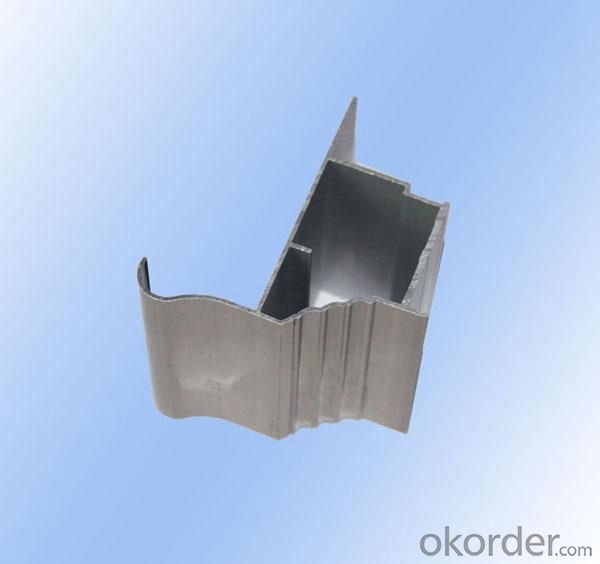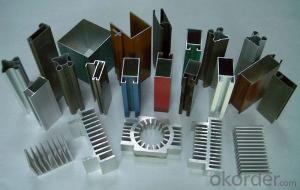Aluminum Alloy Profiles for Office Screenn Office Partition
- Loading Port:
- Shanghai
- Payment Terms:
- TT OR LC
- Min Order Qty:
- 5 m.t.
- Supply Capability:
- 10000 m.t./month
OKorder Service Pledge
OKorder Financial Service
You Might Also Like
Item specifice
1. Specification of Aluminum Alloy Profiles for Office Screenn Office Partition
Alloy | AA1050,AA1060, AA1070, AA1100 |
Temper: | H12, H14, H16, H18, H22, H24, H26, H32,HO, F |
Thickness: | 0.10-500mm |
Width: | 10mm- 2200mm |
Standard: | GB/T3880-2006, ASTM, ISO, EU standard |
Special Specification is available on customer’s requirement | |
2. Application of Aluminum Alloy Profiles for Office Screenn Office Partition
wall cladding, ceilings, bathrooms, kitchens and balconies, shutters, doors,windows…
3. Feature of Aluminum Alloy Profiles for Office Screenn Office Partition
Surface Quality :
Be free from Oil Stain, Dent, Inclusion, Scratches, Stain, Oxide Decoration, Breaks, Corrosion, Roll Marks, Dirt Streaks and other defect which will interfere with use,
Mochenical Property:
Chemical Composite and Mechanical Property
4. Certificate:
SGS and ROHS(if client request, paid by client), MTC(plant provided), Certificate of Origin(FORM A, FORM E, CO), Bureau Veritas and SGS (if client request, paid by client), CIQS certificate
5. Image of Aluminum Alloy Profiles for Office Screenn Office Partition



6. Package and shipping of Aluminum Alloy Profiles for Office Screenn Office Partition
First, plastic cloth with drying agent inside; Second, Pearl Wool; Third, wooden cases with dry agent, fumigation wooden pallets, aluminum surface could cover blue PVC film
7. FAQ
Question 1: What is your MOQ?
We accept one ton per type for an order. But the detail we could negotiate.
Question 2: What is your normal terms of payment?
We always trade with you by T/T. But we also accept the L/C as you require.
Question 3: How many kinds of the surface treatment we can choose?
You could choose different color of powder coated. Anodized of black. matte silver, nature, champagne, bronze color. Mill finished. Wooden finished and printed.etc.
Question 4: Can you supply OEM services?
We offer OEM services for 17 years.
Question 5: How many days for opening the mould?
Normally about 10 days.According to the difficulty of your drawing.
Question 6: Can i choose the package what i want?
Yes, of course. We offer various kinds of package.e.g.PE foam. Shrink film. Wrapping paper.
But we would give you professional suggestion of package.
- Q:Can aluminum profiles be used in elevator or escalator systems?
- Yes, aluminum profiles can be used in elevator or escalator systems. Aluminum profiles are lightweight, durable, and corrosion-resistant, making them suitable for various applications, including the construction of elevator and escalator components. Aluminum profiles can be used for the structural framework, handrails, cladding, and other parts of an elevator or escalator system. Additionally, aluminum profiles can be easily customized and fabricated to meet the specific requirements of each project. Their versatility, strength-to-weight ratio, and aesthetic appeal make aluminum profiles an excellent choice for elevator and escalator systems.
- Q:How do aluminum profiles perform in terms of electrical conductivity?
- Aluminum profiles have relatively low electrical conductivity compared to other metals such as copper or silver, but they still conduct electricity to some extent. They can be used for applications where moderate conductivity is required, but for high-performance electrical applications, other metals may be more suitable.
- Q:Does the profiled bar include aluminum profiles? What are the differences between aluminum and profile?
- Often called special-shaped material from the material include: aluminum alloy profile and PVC profileDoors and windows and other decorative materials are the largest use of profiles
- Q:Aluminum extrusion die, what material is better? Can reach long life, extruded products surface smooth and smooth?
- The main material used now is H13, which is the most common material usedThe problem of life not only with material, heat treatment with you, mold making, mold structure, relationship maintenance and other aspects in the use of Dongxin steel, specializing in the production of aluminum extrusion die material.
- Q:What are the different finishing options available for aluminum profiles?
- The different finishing options available for aluminum profiles include anodizing, powder coating, painting, polishing, brushing, and sandblasting. These options allow for customization in terms of color, texture, and durability. Anodizing provides a protective layer and can be done in various colors. Powder coating offers a wide range of colors and a durable finish. Painting allows for custom colors and designs. Polishing creates a smooth and reflective surface. Brushing creates a brushed metal look. Sandblasting adds texture and can create a matte or satin finish. Overall, these finishing options enhance the aesthetics and functionality of aluminum profiles.
- Q:What are the different color options for aluminum profiles?
- The different color options for aluminum profiles vary depending on the manufacturer and finish. Some common color options include natural silver, black, white, bronze, and various shades of metallic and anodized finishes.
- Q:Can aluminum profiles be used in the production of food processing equipment?
- Yes, aluminum profiles can be used in the production of food processing equipment. Aluminum is a lightweight and corrosion-resistant material, making it suitable for use in the food industry. It is commonly used to construct frames, supports, and components for food processing machinery due to its durability and easy maintenance. Additionally, aluminum profiles can be easily customized and integrated into various equipment designs, making them a versatile choice for food processing applications.
- Q:What are the different accessories available for aluminum profiles?
- There are a wide range of accessories available for aluminum profiles that can enhance their functionality and versatility. Some of the common accessories include: 1. T-nuts: T-nuts are used to create threaded connections within aluminum profiles, allowing for easy attachment of various components such as brackets, panels, and fasteners. 2. Corner connectors: These connectors are used to join aluminum profiles at right angles, enabling the creation of sturdy and rigid structures. They come in various designs, such as external or internal corner connectors. 3. End caps: End caps are used to seal the open ends of aluminum profiles, providing a clean and finished look while also protecting against dust, debris, and potential injuries. 4. Brackets and fasteners: Brackets and fasteners are essential accessories for securing and supporting components within aluminum profiles. They come in various shapes and sizes to accommodate different applications. 5. Panel mounts: Panel mounts provide a secure and convenient way to attach panels, boards, or other flat surfaces to aluminum profiles. They can be easily adjusted or removed as needed. 6. Hinges and handles: These accessories are commonly used in applications where doors, lids, or covers need to be attached to aluminum profiles. Hinges allow for smooth opening and closing, while handles provide a comfortable grip. 7. Cable management solutions: Cable management accessories such as cable clips, cable ducts, and cable ties are available to keep wires and cables organized within aluminum profiles, ensuring a neat and professional appearance. 8. Leveling feet and casters: Leveling feet and casters are useful accessories for aluminum profile-based structures that need to be mobile or require stability on uneven surfaces. Leveling feet help adjust the height and ensure stability, while casters provide mobility. 9. LED lighting solutions: Aluminum profiles are often used for LED lighting applications, and various accessories are available to integrate lighting strips, diffusers, and connectors for a seamless and professional lighting solution. 10. Sensors and switches: Accessories like sensor mounts and switch brackets are designed to integrate sensors or switches into aluminum profiles, allowing for easy installation and integration into automation or control systems. These are just a few examples of the many accessories available for aluminum profiles. The wide range of options allows for customization and adaptation to specific needs and applications, making aluminum profiles a versatile and reliable choice for various industries and projects.
- Q:How do I install aluminum profiles?
- To install aluminum profiles, follow these steps: 1. Start by measuring and marking the desired location where you want to install the aluminum profile. Ensure that the surface is clean and free of any debris. 2. Cut the aluminum profile to the required length using a saw or a miter saw. Make sure the cut is precise and smooth. 3. Use a drill to create pilot holes at regular intervals along the marked installation area. These holes will serve as the anchor points for the screws or bolts that will secure the aluminum profile in place. 4. Attach the aluminum profile to the surface by aligning the pilot holes with the corresponding holes on the profile. Insert screws or bolts through the holes and tighten them using a screwdriver or a socket wrench. 5. If you are installing multiple aluminum profiles, repeat the process for each section, ensuring that they are aligned and securely fastened to the surface. 6. Once all the profiles are installed, check for any gaps or unevenness. If necessary, adjust and tighten the screws or bolts to ensure a snug fit. 7. Finally, clean the installed aluminum profiles with a mild cleaning solution and a soft cloth to remove any dirt or residue. Remember to wear appropriate safety gear, such as gloves and safety glasses, while handling tools and materials during the installation process.
- Q:Are aluminum profiles resistant to chemicals and acids?
- Yes, aluminum profiles are generally resistant to chemicals and acids due to their natural oxide layer that provides a protective barrier against corrosion. However, certain highly corrosive chemicals or acids may still cause damage over time.
1. Manufacturer Overview |
|
|---|---|
| Location | |
| Year Established | |
| Annual Output Value | |
| Main Markets | |
| Company Certifications | |
2. Manufacturer Certificates |
|
|---|---|
| a) Certification Name | |
| Range | |
| Reference | |
| Validity Period | |
3. Manufacturer Capability |
|
|---|---|
| a)Trade Capacity | |
| Nearest Port | |
| Export Percentage | |
| No.of Employees in Trade Department | |
| Language Spoken: | |
| b)Factory Information | |
| Factory Size: | |
| No. of Production Lines | |
| Contract Manufacturing | |
| Product Price Range | |
Send your message to us
Aluminum Alloy Profiles for Office Screenn Office Partition
- Loading Port:
- Shanghai
- Payment Terms:
- TT OR LC
- Min Order Qty:
- 5 m.t.
- Supply Capability:
- 10000 m.t./month
OKorder Service Pledge
OKorder Financial Service
Similar products
New products
Hot products
Related keywords





























